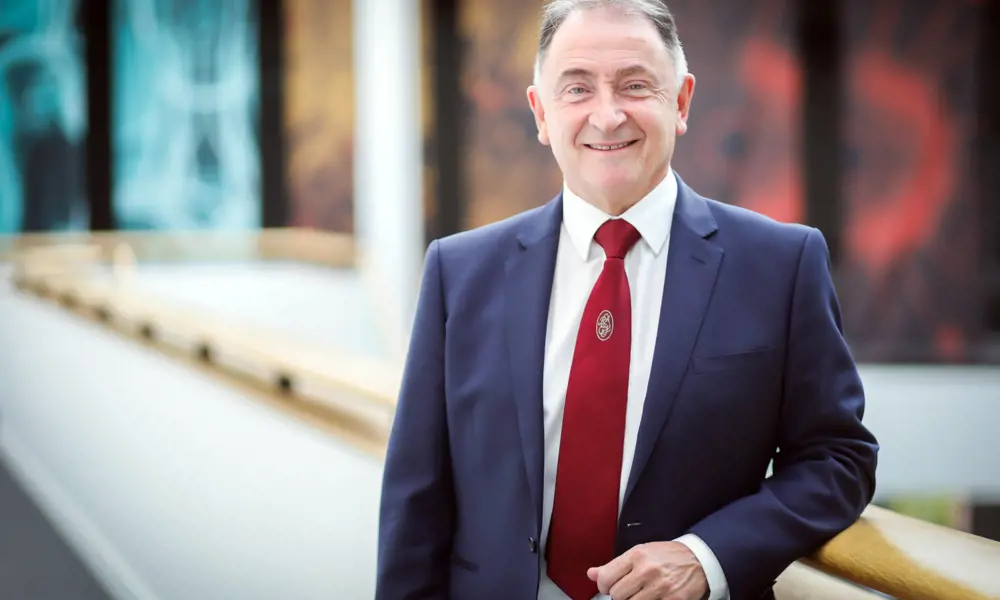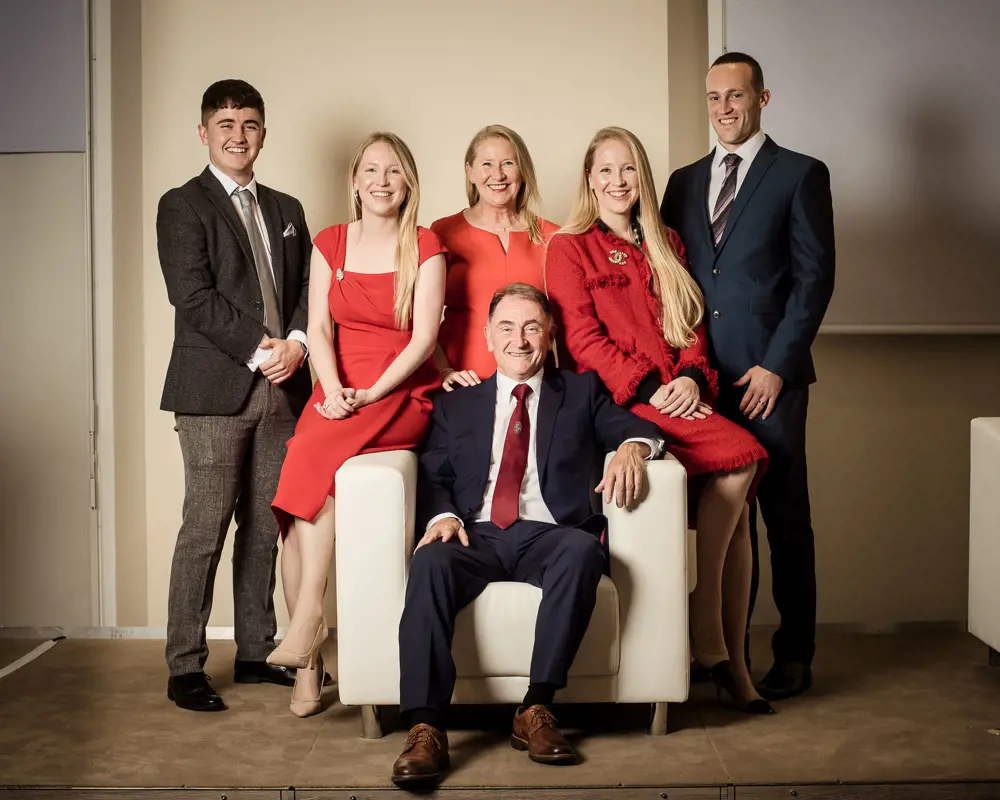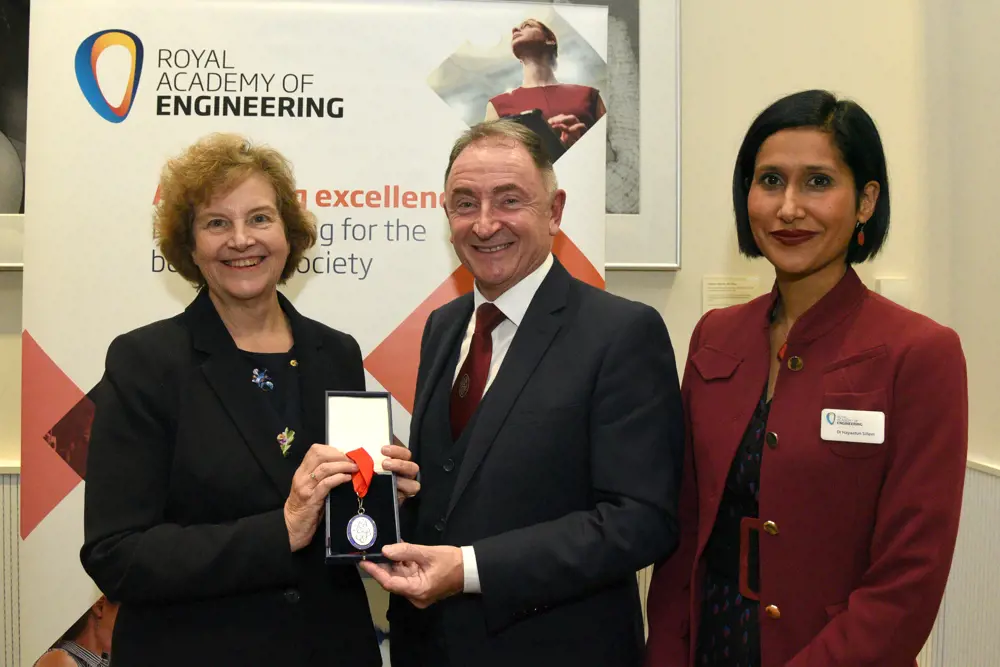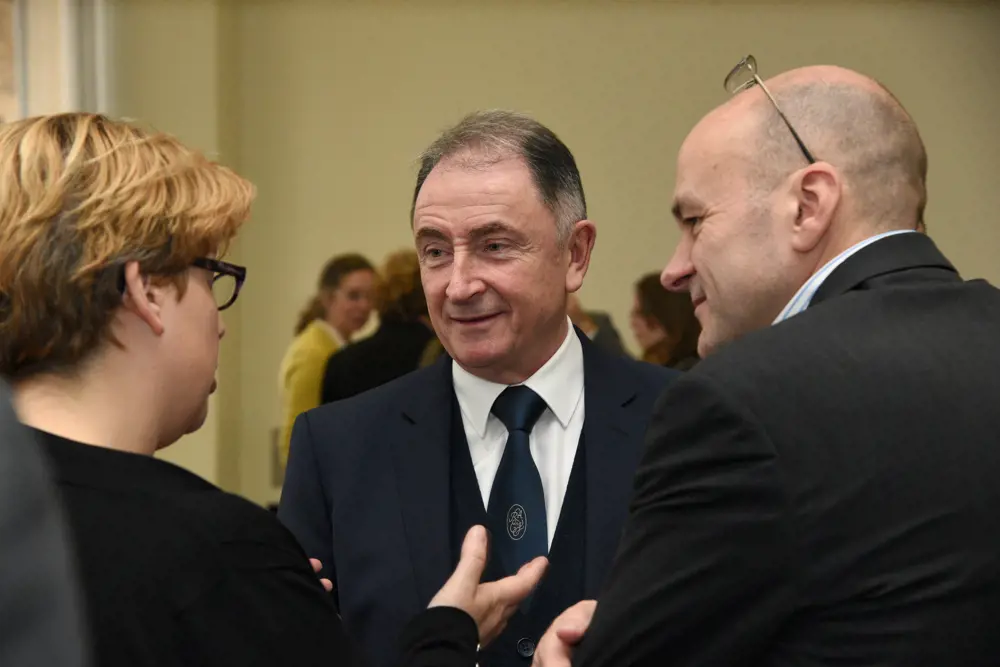
Life in electrifying times

Sir Jim McDonald gets really enthusiastic if you ask about his family. “After the Academy, and Strathclyde, the other thing that I like to talk about is my family. All my three children are engineers, including my twin daughters.” One daughter works on smart grid technologies for UK Power networks, another daughter worked for National Grid before becoming a consultant at Deloittes working in infrastructure and energy. His son is just finishing a master’s degree in electrical and mechanical engineering and when he graduates will join Scottish Power to work in renewable power. “I am very proud of my family,” says Sir Jim. He jokes that, not to be outdone, when mixing in engineering circles his wife, a podiatrist, “calls herself a biomedical engineer” © Martin Gammon
Eminent engineers often mention Meccano and construction toys when asked what sparked their passion for their subject. Sir Jim McDonald adds visits to the rope-making facilities in the docks in Govan and Clydebank where his father worked. “These were very significant manufacturing processes,” he explains. With this experience, and two brothers who were craftsmen, McDonald had a better idea than many of the possibilities of a technical career. “There were a lot of good craftsman skills running down the family,” he says. “I was just surrounded by it. Anything that needed fixing could be fixed by the family.” He still uses his father’s tools.
Unfortunately, the family’s fixing skills did not encompass electronics. “From about the age of 12, I had a dreadful habit of pulling radios apart,” he explains. “I do remember managing to destroy one hire-purchase TV set. I was made to feel very guilty about that.” Far from being a deterrent, if anything the experience spurred him on. “Once I had decided that I couldn’t figure out how it worked, I started having conversations with my physics and maths teachers at school.” Those chats set Sir Jim on the road to a career in electrical and electronic engineering.
Once I had decided that I couldn’t figure out how it worked, I started having conversations with my physics and maths teachers at school
Sir Jim had a practical reason for tackling electronics. Like many young people, he was interested in music, not just as a listener, but as a member of a band. Money earned stacking shelves and doing a paper round went into buying a second-hand electronic amplifier. Not content with how loudly the band could play, Sir Jim tweaked the amplifier’s electronics to turn up the volume. “I was quite proud of myself,” he boasts. “That got me even more interested in electrical and electronic engineering.”
That early interest led to a career as an engineer in electricity distribution, power system economics, and the rise of Scotland’s wind power industry, not to mention heading up the University of Strathclyde, the university that started his career in engineering.
Graduating in electronic and electrical engineering, Sir Jim’s results were good enough to elicit an invitation to study for a PhD. The pull was not powerful enough to compete with another strong influence. Newly married, his wife was a podiatrist, “she was working and earning and was keen that I joined her on that journey.” Sir Jim joined the electricity supply industry where he worked as a transmission and distribution engineer.
Electrical engineering and moving between industry and academia
His encounters with real world engineering began towards the end of his degree course, as a part of the Scottish Electrical Training Scheme (SETS). Sir Jim describes SETS, effectively a graduate apprenticeship, as “a terrific way for me to get into the world of work. While I was a keen engineer, I had no real experience of professional engineering.” Sir Jim first worked in the state-owned electricity industry for the South of Scotland Electricity Board, now Scottish Power, and then the North of Scotland Hydro-Electric Board, now SSE. In the private sector, he spent time with Parsons Peebles, Hayden Young – now part of Balfour Beatty, and Ferranti.
Working in the industry did not kill Sir Jim’s interest in research. “Because I had been offered a PhD it was always in my mind that research studies could be interesting.” He decided to continue his education with a master’s degree in electrical power engineering. South of Scotland Electricity Board didn’t just sponsor that course, it continued its support when Sir Jim decided to start a PhD in power system economics. “The PhD was for me to understand engineering policy and economics. I was broadening myself to be able to pursue maybe a senior industrial career.”
As it turned out, the PhD, in spot pricing of electricity, began his move back into academic life. During that PhD, Sir Jim decided to gatecrash a leading research centre for power system economics at Massachusetts Institute of Technology. “I had done the usual Scottish thing,” says Sir Jim, “I turned up unannounced, during a holiday to Boston. I said ‘I am Jim McDonald, I’m working on power system economics, I really think I could be useful to your research programme.’ After the laughter had died down, they invited me back for a short sabbatical and I completed my PhD.”
I turned up unannounced, during a holiday to Boston. I said ‘I am Jim McDonald, I’m working on power system economics, I really think I could be useful to your research programme
This Scottish invasion of an American university was not part of a grand plan to return to full-time academic life. However, it wasn’t long before Sir Jim was lured back in. At the time universities wanted to recruit people with business experience. “The New Blood Lectureship programme was launched in the UK.” This was, he enthuses, a terrific scheme. “It was structured to get young men and women, who had maybe five to 10 years’ of experience in industry, to go back into academia.” So he returned Strathclyde in 1984 with the notion, he says, of staying for three years. “That was 35 years ago,” he laughs. “I went in, and I truly enjoyed the engagement with students. I loved their energy. I loved their excitement.”
For his part, Sir Jim offered students something a bit different. “I was giving them industrial insights.” That was particularly useful in the latter years of a degree course, “when they are full of theory”. They have spent plenty of time in lectures and laboratories. “Then we start talking about ‘here are the sort of problems that you need to solve’.”
Sir Jim immersed himself in research into electrical power systems and set about establishing facilities for that research. He embarked on this process around the same time that the government was privatising the generation, distribution and supply of electricity in the UK, with inevitable consequences for R&D in the sector. “Moving into private ownership meant that the drivers for innovation and technological impact were shifting.”
“Purely by good fortune,” Sir Jim explains, “we found ourselves in a very strong position to create what we called the Centre for Electrical Power Engineering.” With credible industry experience as a transmission and distribution engineer and because he had started his research group just before privatisation, the academics were in a good position to take their research out of the laboratory and into industry. “We could,” as he puts it in current parlance, “do translational research that was further up that Technology Readiness Level that was relevant to industry. It has been effectively a 25-year journey where we have built strength upon strength. We have kept at the core of that great PhD work and we now have the largest electrical power engineering group in Europe at Strathclyde.”
When Sir Jim was forging his business links, in the 1990s, it was less common for academics, even in engineering, to work closely with industry. Sir Jim was always keen to make an impact. “The thing that always attracted me was the conduct of good curiosity-based research, but user-driven, user-inspired. That worked for me as a young academic with a growing group.” He could pair his industrial experience with his growing research capabilities.
Sir Jim cemented his industry links by working with Rolls-Royce. “I became the Rolls-Royce Professor of Electrical Systems in 1993,” he explains. “It was natural, the Centre for Electrical Power Engineering allowed me to cut my teeth on academic industrial collaborative research. We actually won the Queen’s Anniversary Prize in 1996 for the work that we did on electrical power engineering.”
We heard loud and clear an industry demand statement, and we were able to respond with PhDs, and then to turn the research into a product
Rolls-Royce then made a “big decision”, as Sir Jim puts it, by setting up its first University Technology Centre (Ingenia 47, June 2011) in Electrical Power Systems in 1997 at Strathclyde. Sir Jim sees interesting engineering opportunities in bringing electrical engineering from the power sector into aerospace. “When we look at them structurally, aircraft start to look like flying electrical systems. Which means that we can start to translate what we know works in distributed generation systems, and we can take those architectures into both aerospace and marine applications.”
He illustrates the value of maintaining close links between academics and industry with an example. In 1987, a call came from the chair of the Eastern Electricity Board. It had just come through the trauma of widespread power cuts caused by the massive storms that had brought much of the UK to a halt. “They said ‘Our control room engineers in Ipswich were overwhelmed by telemetry that had come in’.” Far from being helpful, this data flood had made it more difficult for the engineers to restore the system. “They asked ‘Do you guys do anything in data management or AI?’ Well at that time we didn’t.” That soon changed. Sir Jim’s group quickly drew up some PhD projects. “Within three or four years we had implemented, as we called them in those days, expert system decision support tools for the control room.”
Sir Jim sees this as a nice vignette of the technology readiness level journey. “We heard loud and clear an industry demand statement, and we were able to respond with PhDs, and then to turn the research into a product.”

Past President Dame Ann Dowling OM DBE FREng hands over the Presidential medal to Sir Jim, with CEO Dr Hayaatun Sillem CBE
Spinouts and enterprise
This leads into a discussion into the role of spinout companies in commercialising university research. Sir Jim has been involved in several power and energy spinouts. For example, Bellrock Technology grew out of university work on AI. The company, still based in Glasgow, sells AI tools and techniques to the power industry.
Another spinout company, Smarter Grid Solutions, supplies software that helps power companies to manage electricity generation from distributed sources of renewable energy, an increasingly important area of research at Strathclyde.
Sir Jim then mentions another business based on power engineering that also draws on optoelectronics, another of Strathclyde’s strengths. Synaptec, founded in 2014, uses fibre Bragg grating sensors on a single optical fibre to measure current, voltage, vibration, and temperature in power networks. The sensors can monitor the health of power networks that have to accommodate an array of renewable energy sources.
These spinouts are good examples of how Strathclyde’s academic research has facilitated the growth of ‘clusters’ of companies in power technology and photonics. The clusters have also attracted research organisations that can help to accelerate the conversion of academic research into commercial applications.
For example, Sir Jim was involved in bringing the Offshore Renewable Energy Catapult to Glasgow eight years ago and is its senior independent director. “I think that Catapult can claim to have had a significant contribution to reducing the cost of offshore wind energy by two thirds.” The university also hosts another Catapult, the Advanced Forming Research Centre, Scotland’s only High Value Manufacturing Catapult centre. Glasgow is also a home to the Medicines Manufacturing Innovation Centre. In photonics, Sir Jim mentions the Fraunhofer Centre for Applied Photonics, the UK’s only Fraunhofer, he adds. “One of the things that attracted them to us was our deep strategic commitment to the translation of our research into industrially applicable outcomes.”
Sir Jim was also behind moves to provide another essential ingredient in the development of technology clusters and startup businesses: finance. Four years ago, he was behind the creation of Strathclyde’s Enterprise and Investment Committee. He can even point to local connections who championed the idea of the Academy’s own Enterprise Hub, now in its seventh successful year. “Hub founder Ian Shott was the founding chairman of our industrial and biotech innovation centre at Strathclyde.”
As Sir Jim describes it, Industry 4.0 is about data science, sensing, AI, robotics, and automation
Is there something about Glasgow that attracts these activities? “I am conscious that I shouldn’t be talking too much about my own place, but you can’t help it. I have to be careful not to put a kilt on this too often,” he jokes. But there is no denying that the place has its attractions. He cites a recent example when, in 2017, the Scottish Government announced that Strathclyde would be the anchor university for the National Manufacturing Institute for Scotland (NMIS). With an investment of £65 million, NMIS will be heavily involved in skills and training and in research.
It could also play a role in Scotland’s response to the concept of Industry 4.0. Sir Jim see this as a “classic example” of the challenges and opportunities facing engineering and manufacturing. The concept, also dubbed the fourth industrial revolution, will change the shape of manufacturing. As Sir Jim describes it, Industry 4.0 is about data science, sensing, AI, robotics, and automation. “It is a fantastic opportunity for the UK to recognise the challenge for society, to engage with this, but to highlight the opportunity and, very importantly, to capture the economic value in the UK.”

Sir Jim McDonald at Buckingham Palace receiving the Queen’s Anniversary Prize for Higher and Further Education from His Royal Highness The Prince of Wales. He received the award on behalf of the University of Strathclyde, which was selected as a winner for its excellence in energy innovation
Evidence-based policy
This takes the conversation into the broader area of policy and his new role at the Academy. His position at Strathclyde and in Scotland has given him plenty of experience to draw on. With Scotland’s First Minister, he has co-chaired the Scottish government’s energy advisory board since its inception. He describes this as “an excellent way for him to see how independent analysis generates data and how the evidence can be compelling.”
On the research side, Sir Jim also chairs Scotland’s Energy Technology Partnership, an alliance of 13 Scottish Higher Education Institutions. Supported and co-funded by the Scottish Funding Council, the partnership supports industry in and beyond the Glasgow energy cluster with energy R&D. Yet another role for Sir Jim is as chair of the Scottish Research Partnership in Engineering.
Sir Jim sees these activities as important in maintaining links with the research community. “It would be unfair to claim that I am leading research,” he adds. “But I’m still well engaged with the research community.” Research contacts are an invaluable source of the evidence that should guide informed policy decisions. Sir Jim has been around long enough to know that you cannot force politicians to follow evidence. However, as he puts it, “if you can get a strong evidence base, and you can gather support from business, industry, and civil servants who have been persuaded of the argument, my experience has been that it can be remarkably powerful.”
For Sir Jim, the Academy’s new National Engineering Policy Centre is “a fantastic asset. We are working in partnership with 39 other professional engineering institutions,” he explains. He describes the Centre’s recent report, Engineering priorities for our future economy and society, as “a solid piece of work that should set the tone for the new government”.
Career timeline and distinctions
Transmission and Distribution Engineer, 1978. Joined University of Strathclyde, 1984. Professor of Electrical Power Systems, 1993. Fellow of the Royal Academy of Engineering, 2003. Principal and Vice-Chancellor of the University of Strathclyde, 2009. Awarded knighthood, 2012. Elected President of the Royal Academy of Engineering, 2019.
Net zero ambitions
Another current study is on the systems approach to decarbonising the UK’s energy system. This touches on one of today’s most important policy issues where convincing evidence is essential: climate change and the ambition to achieve ‘Net Zero’ – eliminating the UK’s emissions of CO2 into the atmosphere. Sir Jim has previously worked with Chris Stark, chief executive of the Committee on Climate Change (CCC), the body that advises the government on emissions targets and preparing for climate change. “He and I worked very closely to generate the Scottish government’s energy systems strategy. I think you will see echoes of that commitment in the CCC’s recommendations for climate change Net Zero. That has had a remarkably quick impact on the UK government’s commitment to addressing these climate change problems.”
Some of the biggest impacts of moves to Net Zero will be in the electrical power industry. Across Europe there will be hundreds of billions-worth of investment in grid infrastructure, in energy sources, but it cannot be just more of the same, Sir Jim insists. “It has to be smart grid. It has to be low-carbon power sources. It has to be electrification of transport.” Strathclyde has been preparing for this. “The whole notion of energy systems is where we have moved our research over the past 10 years.”

Sir Jim in his role of Chair of the Academy’s Research Committee at the annual Research Forum, which showcases world-class engineering research funded by Academy programmes
Sir Jim plans to put sustainability, and the target for the UK to achieve Net Zero emissions of carbon dioxide, at the heart of his work at the Academy. “What I’m hoping to do with my colleagues in the Academy, and with the Fellowship and our partners, is to put global sustainability at the heart of what we are doing. Very importantly for me, engineering is a big part of how we might deliver that. The policy frameworks have to be in the right shape, investment opportunity has to be there because we need to build industries and economic opportunity, but the real thing that is going to make a difference is engineering that future.”
While saving the planet is clearly essential, Sir Jim sees other benefits in striving for Net Zero. “There is a real opportunity for the UK to come up with its solutions to meet the Net Zero carbon targets and at the same time build market opportunity.” By leading the way in developing and implementing new technologies, the UK can become a showcase for the rest of the world. “It will also attract people from around the world to come here to be both educated and inspired by the fact that the UK is implementing low-carbon solutions. Of course, this is something we will demonstrate this year when the UK hosts COP26 in Glasgow. The eyes of the world will be on us in November at this meeting and expectations are growing for agreements to be settled and acceleration from words to action as a matter of urgency.”
There is a real opportunity for the UK to come up with its solutions to meet the Net Zero carbon targets and at the same time build market opportunity
It will require a massive effort to achieve these changes. “What we’re finding now is that the multiple challenges of decarbonising energy, achieving energy efficiency, changing the face of transport, are going to need multiple engineering skills. The Academy can help move us from what is a problem space to a solution space, using the full spectrum of our engineering expertise across the Fellowship.”
On the broader front, Sir Jim expects the Academy to play a significant role in the government’s ambition to increase the UK’s investment in R&D to 2.4% of GDP. “If we achieve that, it will be another £15 billion per annum going into R&D, two thirds of which is expected to come from private sector sources.” Sir Jim believes it will be critically dependent upon collaboration between industry and academia. But industry and business need to see benefit there. “That is where the Academy has an important role to play, to connect the academic and industrial communities, to help to deliver what is a major policy target.” Fortunately, Sir Jim has personal experience on all three fronts, academia, industry and policy.
***
This article has been adapted from "Life in electric times", which originally appeared in the print edition of Ingenia 82 (March 2020).
Contributors
Michael Kenward OBE
Author
Keep up-to-date with Ingenia for free
SubscribeRelated content
Electricals & electronics

Accelerometers
Used in earthquake measurements, laptops, planes and even in stargazing apps, today’s accelerometers are much smaller than when they were first developed in 1927. Find out how they detect movement and vibration.

How to maximise loudspeaker quality
Ingenia asked Dr Jack Oclee-Brown, Head of Acoustics at KEF Audio, to outline the considerations that audio engineers need to make when developing high-quality speakers.

Cable fault locator
The winner of the Institute of Engineering and Technology’s 2014 Innovation Award was EA Technology’s CableSnifferTM, which uses a probe and chemical sensing technology to identify faults, saving energy companies millions of pounds each year.

High speed evolution
In December 2010, Eurostar International Ltd awarded a contract for 10 new high speed trains to Siemens. The company has used a system developed over decades to maximise the performance and passenger-carrying ability of its 320km/h trains.
Other content from Ingenia
Quick read

- Environment & sustainability
- Opinion
A young engineer’s perspective on the good, the bad and the ugly of COP27

- Environment & sustainability
- Issue 95
How do we pay for net zero technologies?
Quick read

- Transport
- Mechanical
- How I got here
Electrifying trains and STEMAZING outreach

- Civil & structural
- Environment & sustainability
- Issue 95